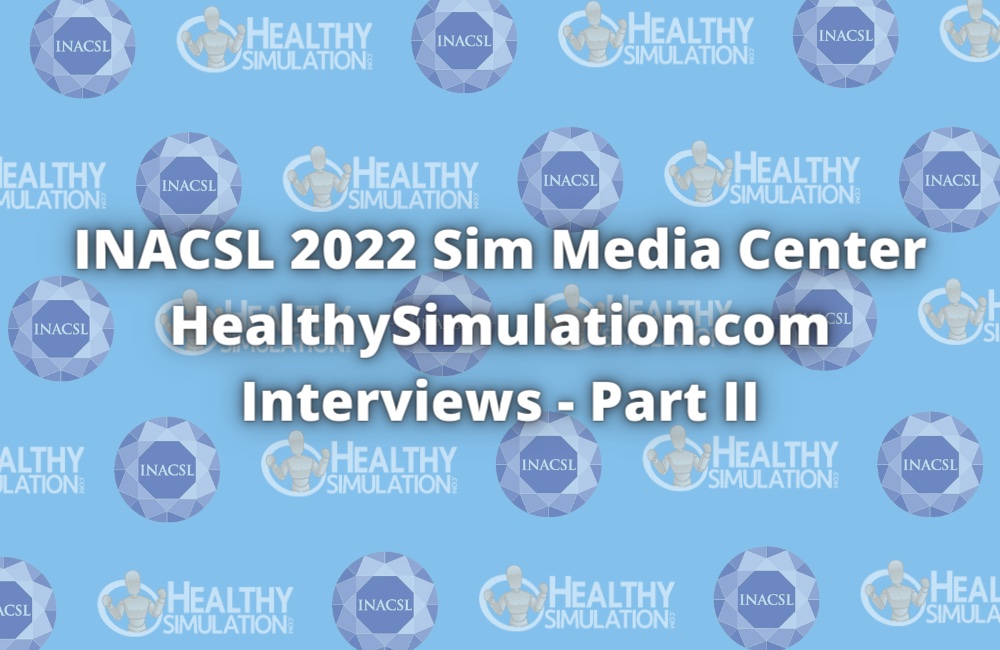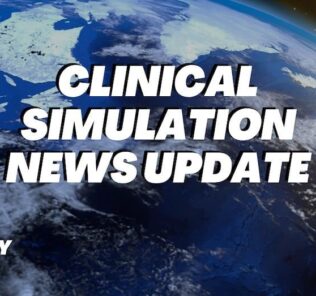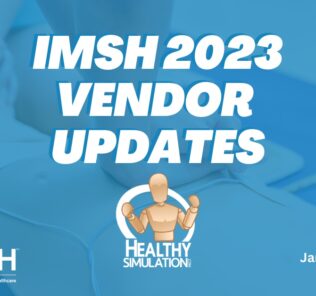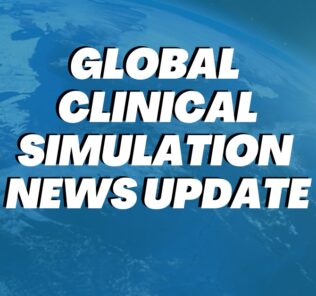INACSL 2022 Sim Media Center HealthySimulation.com Interviews – Part II
HealthySimulation.com was in attendance at the 2022 International Nursing Association of Clinical and Simulation Learning (INACSL) annual conference in mid-June in Milwaukee, Wisconsin. As part of this year’s event, themed “Stronger Together,” HealthySimulation.com helped facilitate the Sim Media Center to host interviews with leaders across the healthcare simulation industry. This HealthySimulation.com article is the second in a series highlighting excerpts from these interviews, with this one sharing commentary from representatives of INACSL and representatives from SimX and GigXR.
INACSL 2022 Sim Media Center HealthySimulation.com Interviews – “Let’s Talk Sim” Podcast
HealthySimulation.com: Tell [us] a little bit more about what [INACSL] is doing with this new podcast.
Sponsored Content:
Jennifer Alderman, Ph.D., RNC-OB, CNL, CNE, CHSE (Clinical Associate Professor at UNC-Chapel Hill School of Nursing): “Let’s Talk Sim” actually was born in our membership engagement committee. We began talking about that in our small committee maybe a year and a half to two years ago – mid or beginning of the pandemic. We had an idea that we wanted to interview simulation experts in different topic areas, and we actually originally caught an interview with an innovator.
That was the first buzzword kind of title, but what it evolved into is “Let’s Talk Sim,” we really wanted to get expertise out there, particularly during the pandemic when folks were looking for resources to do virtual simulations. We were all doing virtual versus face-to-face. That’s how the conversation started. We wanted to kind of corral this expertise as a resource, but INACSL at the time did not have the infrastructure to really put it out. They wanted to, we had talked about webinar versus podcast, and then some changes were made with [the] infrastructure and they were able to finally launch the podcast this Spring.
HealthySimulation.com: Tell [us] about some of the episodes that you guys have had so far and, some of the interviews that you’ve been able to provide.
Dr. Alderman: So we started off with Dr. Margaret Verkuyl from Canada. She’s doing a lot of work in virtual sim. She’s an expert in that. I actually heard her speak last year at an INACSL virtual conference, which is why she was on my radar. She kicked off our series, and she was our episode one guest. She talked about virtual sim and some of the work she’s doing in Canada.
Sponsored Content:
Episode two was around virtual reality and we had a couple of experts. Tracy Chesney, Ph.D. (c), MSN-Ed, RN, CNE, CHSE, CHSOS, and Marian Luctkar-Flude, RN, Ph.D., CCSNE, FCNEI was our expert on episode two. Our guest for episode three is Dr. Cynthia Foronda Ph.D., RN, CNE, a longtime leader at INACSL, and a faculty member at the University of Miami. She’s gonna talk about her DEI diversity and inclusion equity and inclusion work, incorporating cultural humility into simulation. She has a cultural sim toolkit as a resource when you’re developing simulation, so be sure to include that.
INACSL 2022 Sim Media Center HealthySimulation.com Interviews – The Future of XR in Simulation
HealthySimulation.com: What has navigating through COVID-19 been like for GIGXR?
Joy Jacobs (VP North American Sales at GigXR): We moved our headquarters from the U.K. to Los Angeles in December of 2019. We found that the UK, Australia, and New Zealand were severely logged down and their lockdown extended a long period of time – way longer than all of us experienced. What they’ve done is embrace the technology and students doing the remote [work]. As they can bring them back in, in person they’re really experiencing the HoloLens to its max.
So that’s where a lot of our data points have come from – the remote, no geographical boundaries. You don’t have to be near a computer. You don’t have to be in a sim lab. You can actually do an immersive simulation experience in your living room. As I said, a lot of our data points have come from these countries. So we made lemonade out of lemons.
HealthySimulation.com: Tell me a little bit about your reflections on XR for utilization of medical devices/components in the sim lab room with regards to the technology-specific perhaps to the institution, and bringing those into the live simulation environment.
Joy Jacobs: In our Holo scenarios, we have a full simulation environment of the hospital room. You’ve got your airway card, you’ve got your ultrasound machine, you’ve got every diagnostic that you need, to completely treat or diagnose this patient. The beautiful thing is that back in the day when I was designing sim centers, we had to plum in compress hair. Nobody had heard of having a compressor to run your simulator. We never thought of expanding our space in that regard.
Then we got into reselling refurbished equipment, and before you knew it, the capital budget was taken by all these diagnostics that you might use in one or two stimulations. Now with VR/AR you can have that ultrasound machine, the muscle memory that you need your learners to have when they’re in a tight situation. The EV bells and whistles are going off and they need to remember “A, B, C, D, E, and I need this ultrasound machine. I need this airway card. I need this, I need this.”
You are able to create that environment with minimal expense. Once we develop that specific tool or device, whatever it is, or that cart, but bring that in it’s like copy and pasting. All of a sudden hundreds of thousands of dollars worth of medical device equipment are easily available for you to utilize and train again, remote 24/7 distance – wherever you need them to be. We’re not looking for your technique. We’re looking that you’re prioritizing that you’re identifying that you need these diagnostics and you need them in this order to treat this patient.
HealthySimulation.com: Ryan, what’s been going on for you guys over the past two years with COVID-19, and what have you been seeing from the community?
Ryan Ribeira (SimX CEO): Probably 80%+ of our customers have come during the pandemic. I think that that just tells you how much it drove adoption and I think there were a couple reasons for that. One was that sim centers were shut down and so people are looking for a way to continue to train with simulation, and a lot of clinical experiences were shut down too for trainees. They needed to maintain those skills and there weren’t that many options available to them. You can’t really social distance in a traditional sim center context. Our product allows [them] to join via the internet and work together around virtual patients, even if [they] are at home.
A lot of our customers were doing that. They were having students check out headsets, and take them home, joining together over the internet. Their instructor is also joining together over the internet and they’re able to debrief remotely and all that kind of stuff. That was huge for us, from a business perspective, and for our customers to be able to continue their sim.
The other thing that I didn’t really expect that was really valuable is that one of the benefits of VR is that these cases are virtualized. This makes it easy for you to share them from person to person. At the beginning of the pandemic, we made some COVID training cases that I happen to be working clinically at Stanford in Santa Clara County, which is one of the big early surge areas.
A lot of our other doctors were in Washington where things were surging early. We were two months into the pandemic releasing cases that describe how to properly triage a COVID patient, and how to treat a COVID patient based on what we knew then at that time. We released those for free on the internet over 400 institutions downloaded them within the first month.
More About INACSL
INACSL’s mission is to advance the science of nursing simulation by providing worldwide professional development, networking resources, and leadership in defining healthcare simulation standards of best practice. Formally naming itself INACSL or the International Nursing Association for Clinical Simulation and Learning in 2002, the organization has grown from an all-volunteer organization based in Texas to a worldwide resource with over 2500 members. INACSL educational materials and resources can be used by anyone.
INACSL holds an annual four-day conference every June in various centers around the United States and Canada. The conference focus is mostly geared toward Nursing Education at the undergraduate and graduate levels. Hospital education departments could also benefit from conference attendance. These events provide education sessions, research results, networking opportunities, and vendor exhibits for leading companies such as Laerdal, CAE Healthcare, SimulationIQ, Gaumard, B-Line Medical, KBPort, Pocket Nurse, 3D Systems, and more. In addition, INACSL provides webinars, leadership book clubs, and journal roundtables in a virtual format.
INACSL is accredited as a provider of continuing nursing education by the American Nurses Credentialing Center’s Commission on Accreditation. In addition to the standards of best practice, INACSL offers other online resources including homegrown solutions links, a bibliography of simulation articles, and resources for researchers. INACSL publishes the journal Clinical Simulation in Nursing with Dr. Nicole Harder as the current Editor-in-Chief.
Learn More About INACSL
Lance Baily, BA, EMT-B, is the Founder / CEO of HealthySimulation.com, which he started in 2010 while serving as the Director of the Nevada System of Higher Education’s Clinical Simulation Center of Las Vegas. Lance also founded SimGHOSTS.org, the world’s only non-profit organization dedicated to supporting professionals operating healthcare simulation technologies. His co-edited Book: “Comprehensive Healthcare Simulation: Operations, Technology, and Innovative Practice” is cited as a key source for professional certification in the industry. Lance’s background also includes serving as a Simulation Technology Specialist for the LA Community College District, EMS fire fighting, Hollywood movie production, rescue diving, and global travel. He and his wife live with their two brilliant daughters and one crazy dachshund in Las Vegas, Nevada.
Sponsored Content:


















